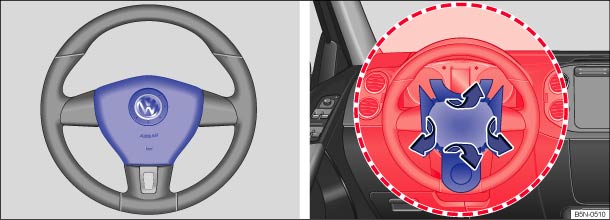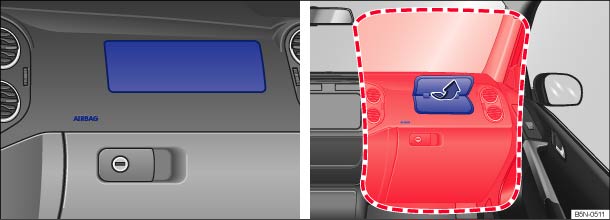Volkswagen Tiguan Owners Manual: Front airbags

Fig. 69 Location and deployment zone of the driver front airbag.

Fig. 70 Location and deployment zone of the front passenger front airbag.
 Read and follow the introductory information and
safety information first⇒
Read and follow the introductory information and
safety information first⇒ Introduction
to the subject
Introduction
to the subject The vehicle is equipped with an Advanced Airbag System in compliance with the United States Federal Motor Vehicle Safety Standard (FMVSS) 208 or the Canada Motor Vehicle Safety Standard (CMVSS) 208 applicable at the time your vehicle was manufactured. The airbag for the driver is in the steering wheel hub ⇒ Fig. 69 and the airbag for the front passenger is in the instrument panel ⇒ Fig. 70 . The general location of the airbags is marked AIRBAG.
The safety belts for the front seating positions have safety belt pretensioners which help take up slack in the belts. The airbag control unit also activates the belt pretensioners ⇒ Airbags and how they work .
The safety belts for the front and rear outboard seating positions also have belt load limiters to reduce the forces acting on a body during an accident.
The areas marked in red (dotted lines) ⇒ Fig. 69 and ⇒ Fig. 70 indicate the airbag deployment zone. Never place or attach accessories or other objects (such as cup holders, telephone brackets, notepads, navigation systems, large, heavy or bulky objects) on the doors, on the windshield, over or near the area marked in red (dotted lines).
Front airbags will not deploy:
- if the ignition is switched off when a crash occurs,
- in side collision,
- in rear-end collisions,
- rollovers,
- when the crash deceleration measured by the airbag system is less than the minimum threshold needed for airbag deployment as registered by the electronic control unit.
The front passenger front airbag will also not deploy:
- when the front passenger seat is not occupied,
- when the weight on the front passenger seat as sensed by the Advanced Airbag System indicates that the front airbag on the passenger side must be switched off by the electronic control unit (the PASSENGER AIR BAG OFF light ⇒ Airbags and how they work comes on and stays on).

 Danger!
Danger!
- A child in a rearward-facing child seat installed on the front passenger seat will be seriously injured and can be killed if the front airbag inflates.
- The inflating airbag will hit the child seat or infant carrier with great force and will smash the child seat and the child against the seat backrest, center armrest, door, or roof.
- Always install rearward-facing child seats on the rear seat.
- Although the Advanced Airbag System in your vehicle is designed to turn off the front airbag when a rearward-facing child restraint has been installed on the front passenger seat, nobody can absolutely guarantee that deployment is impossible in all conceivable situations that may happen during the useful life of your vehicle.
- If you have, in exceptional circumstances, nevertheless decided to install
a rearward-facing child seat on the front passenger seat and the PASSENGER AIR
BAG



 light does not come on and stay on whenever the
ignition is on, immediately install the rearward-facing seat in a rear seating
position and have the airbag system inspected immediately by an authorized Volkswagen
dealer or an authorized Volkswagen Service Facility.
light does not come on and stay on whenever the
ignition is on, immediately install the rearward-facing seat in a rear seating
position and have the airbag system inspected immediately by an authorized Volkswagen
dealer or an authorized Volkswagen Service Facility.

 Danger!
Danger!
- All vehicle occupants and especially children must be restrained properly whenever riding in a vehicle. An unrestrained or improperly restrained child could be injured by striking the interior or by being ejected from the vehicle during a sudden maneuver or impact. An unrestrained or improperly restrained child is also at greater risk of injury or death through contact with an inflating airbag.
- Accident statistics show that children are safer on the rear seat than on the front seat.
- A suitable child restraint properly installed and used at one of the rear seating positions provides the highest degree of protection for infants and small children in most accident situations.
- An Advanced Airbag System can deploy with the “low risk” option for 3 to 6-year-old children when a child who is heavier than the combined weight of a typical 1-year-old child plus child seat is secured on the passenger seat in a forward-facing or rear-facing child restraint that was used to certify your vehicle, and when the other conditions for airbag deployment are met.
- For their own safety, all children, especially those 12 years and younger, must always sit on the back seat, properly restrained for their age and size.
- When installing a child restraint, always carefully follow the manufacturer's instructions.
- If the airbag indicator light goes on while driving, have the system inspected immediately by your authorized Volkswagen dealer or authorized Volkswagen Service Facility. A lit indicator light means the airbags may not work properly if activated in a crash.
- Always make sure that the status signaled by the PASSENGER AIR BAG



 light is correct for the way that the front passenger
seat is being used.
light is correct for the way that the front passenger
seat is being used.

 Warning
Warning
- Objects between you and the airbag will increase the risk of injury in a crash by interfering with the way the airbag unfolds and/or by being pushed into you as the airbag inflates.
- Never hold things in your hands or on your lap when the vehicle is in use.
- Never place accessories or other objects (such a cup holders, telephone brackets, notepads, navigation systems, or things that are large, heavy, or bulky) on the doors or attach them to the doors; never place them over or near the area marked AIRBAG on the steering wheel, instrument panel, or seat backrests, or between those areas and someone in the vehicle ⇒ Fig. 69 and ⇒ Fig. 70 . Such objects could cause serious injury in a collision, especially if an airbag inflates.
- Never attach accessories to the windshield above the passenger front airbag, such as GPS navigation units or music players. Such objects could cause serious injury in a collision, especially if an airbag inflates.
- Never recline the front passenger seat to transport objects. Items can also move into the deployment area of the side airbags or the front airbag during braking or in a sudden maneuver. Objects near the airbags can fly dangerously through the passenger compartment and cause injury, particularly when the seat is reclined and the airbags inflate.
- Always make sure that there is nothing on the front passenger seat that will cause the weight-sensing mat in the seat to sense that the seat is occupied by a person when it is not, or to signal that it is occupied by someone who is heavier than the person actually sitting on the seat. The weight of an object could cause the passenger front airbag to be turned on when it should be off, or could cause the airbag to work in a way that is different from the way it would have worked without the added weight.
- Always make sure that nothing is on the front passenger seat when the backrest is folded forward. Even light objects could be pushed into the seat cushion and cause the weight-sensing mat in the seat to register enough weight to turn the airbag on.
- Always make sure that the status signaled by the PASSENGER AIR BAG



 light is correct for the way that the front passenger
seat is being used.
light is correct for the way that the front passenger
seat is being used.

 Warning
Warning
- Always hold the steering wheel with both hands on the outside of the steering wheel rim at the 9:00 o'clock and 3:00 o'clock positions to help reduce the risk of personal injury if the driver's airbag inflates.
- Never hold the steering wheel at the 12 o'clock position or with your hands anywhere inside the steering wheel or on the steering wheel hub. Holding the steering wheel the wrong way increases the risk of severe injury to the arms, hands, and head if the driver airbag deploys.

 Warning
Warning
- To reduce the risk of breathing problems, those with asthma or other respiratory conditions should get fresh air right away by getting out of the vehicle or opening windows or doors.
- If you are in a collision in which airbags deploy, wash your hands and face with mild soap and water before eating.
- Be careful not to get the dust into your eyes, or into any cuts, scratches or open wounds.
- If the residue should get into your eyes, flush them with water.

 Warning
Warning
- Use only original equipment airbags approved by Volkswagen and installed by a trained technician who has the necessary tools and diagnostic equipment to properly replace any airbag on your vehicle and assure system effectiveness in a crash.
- Never permit salvaged or recycled airbags to be installed in your vehicle.

Undeployed airbag modules and safety belt pretensioners are classified as Perchlorate Material. Special handling may apply – see http://www.dtsc.ca.gov/hazardouswaste/perchlorate. Obey all applicable legal requirements regarding handling and disposal of the vehicle or parts of its restraint system, including airbag modules and safety belts with pretensioners. Authorized Volkswagen dealers and authorized Volkswagen Service Facilities are familiar with the requirements, and we recommend that you have them perform this service for you.
 The dangers of using child restraints on the front seat.
The dangers of using child restraints on the front seat.
Read and follow the introductory information and
safety information first⇒Introduction
to the subject The airbag on the front passenger side makes the front seat a
potentially dangerous plac ...
 Advanced Airbag System components
Advanced Airbag System components
Read and follow the introductory information and
safety information first⇒Introduction
to the subject The front passenger seat in your vehicle has a lot of very important
parts of the Advanc ...
See More:
Volkswagen Tiguan Service and Repair Manual > Wheels, Tires, Wheel Alignment: Wheel, Changing and Mounting
General Information
WARNING
The secure seating of the wheel bolts and the wheels is only ensured if the
instructions and checks below are followed.
Note
After removing or installing one or multiple tires, the tire pressure
monitoring system must be recalibrated for vehicles with tire pressure
mon ...
Volkswagen Tiguan Owners Manual
Volkswagen Tiguan Service and Repair Manual
- Body exterior
- Body Interior
- General Paint Information
- Paint
- Brake System
- Suspension, Wheels, Steering
- Wheel and Tire Guide
- Towing Guide
- Wheel and Tire Guide General Information
- Communication
- Electrical Equipment General Information
- Electrical Equipment from 06/2011
- Heating, Ventilation and Air Conditioning
- Refrigerant R134a Servicing
- 6-Speed Manual Transmission 02Q, OBB, and OFB
